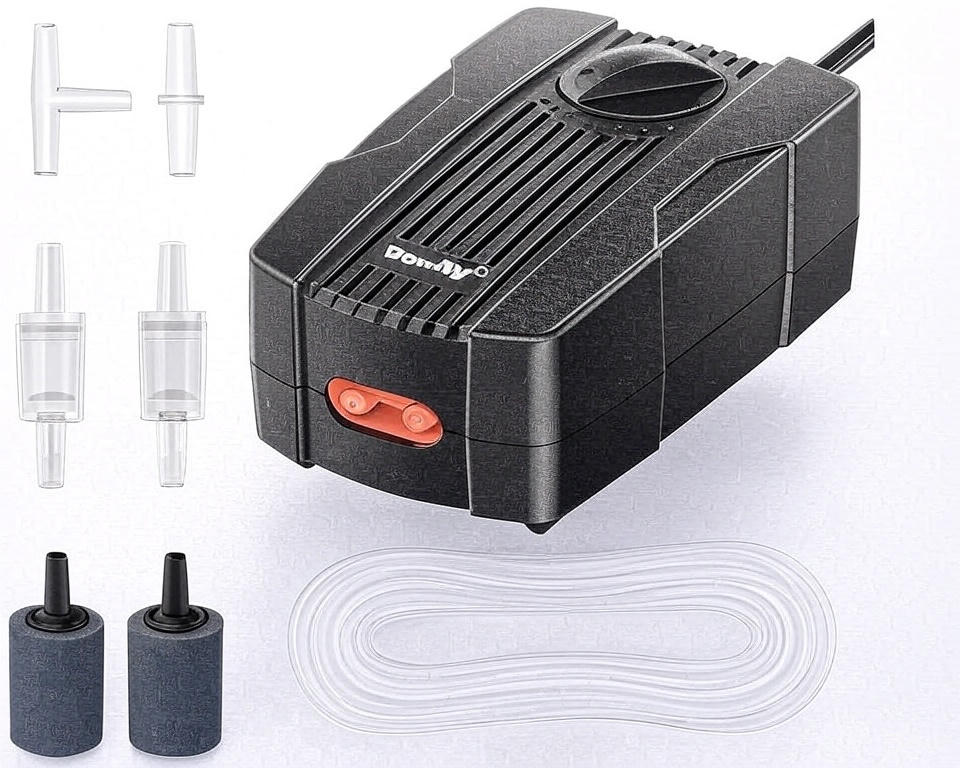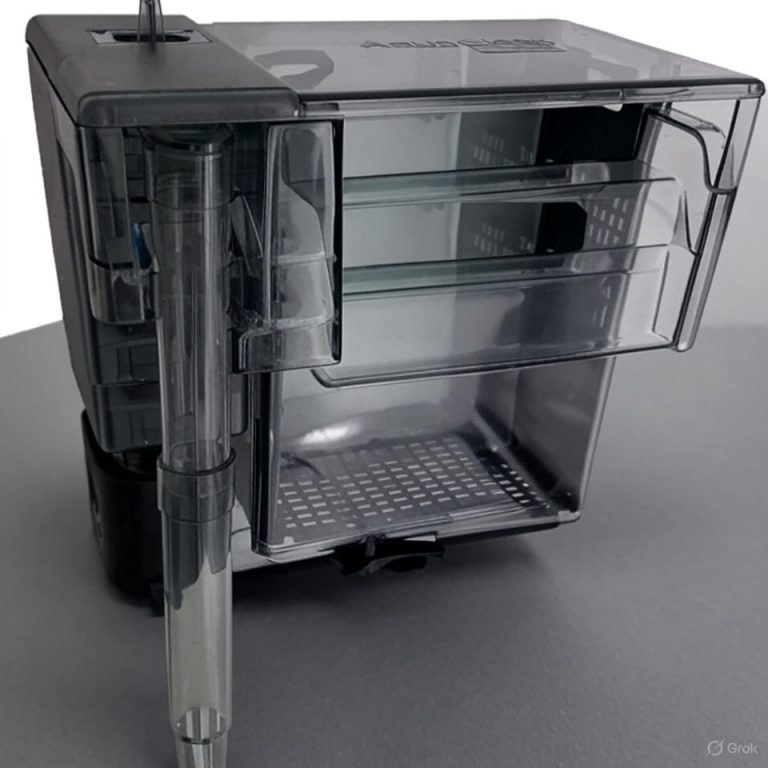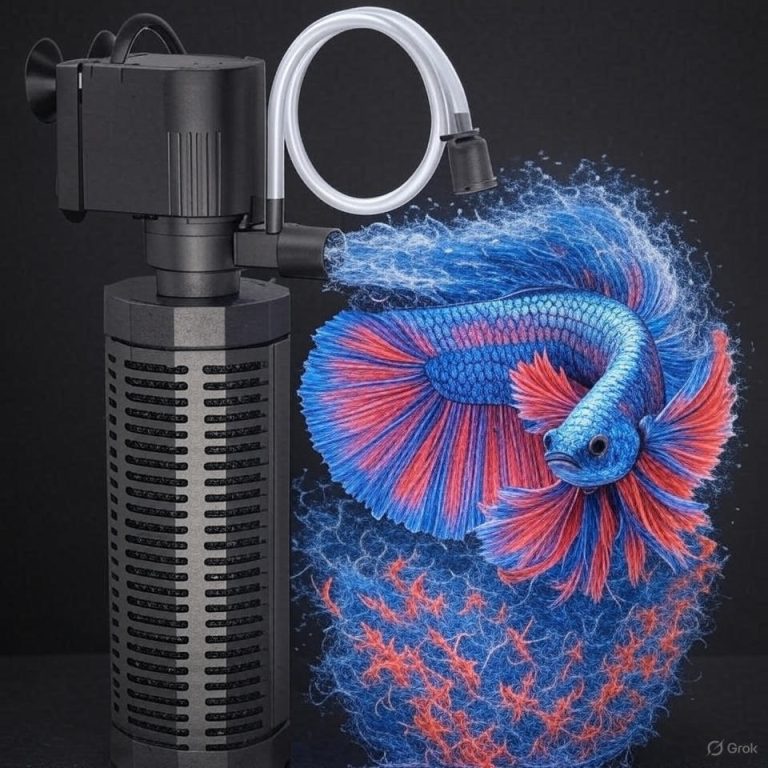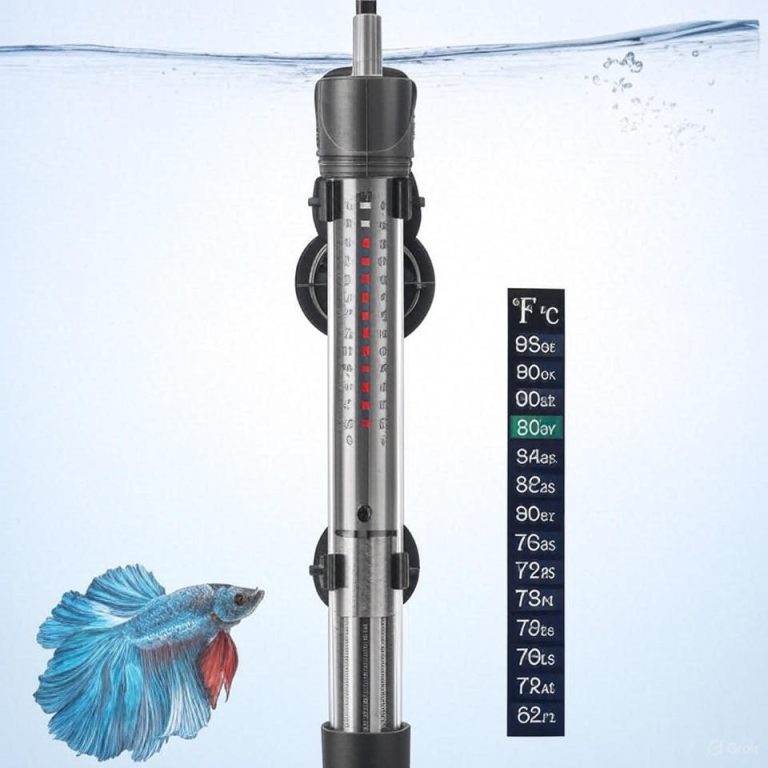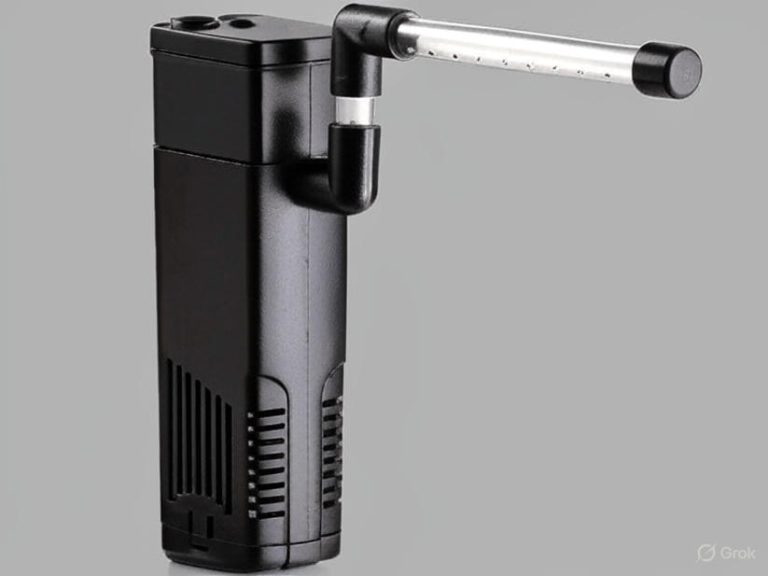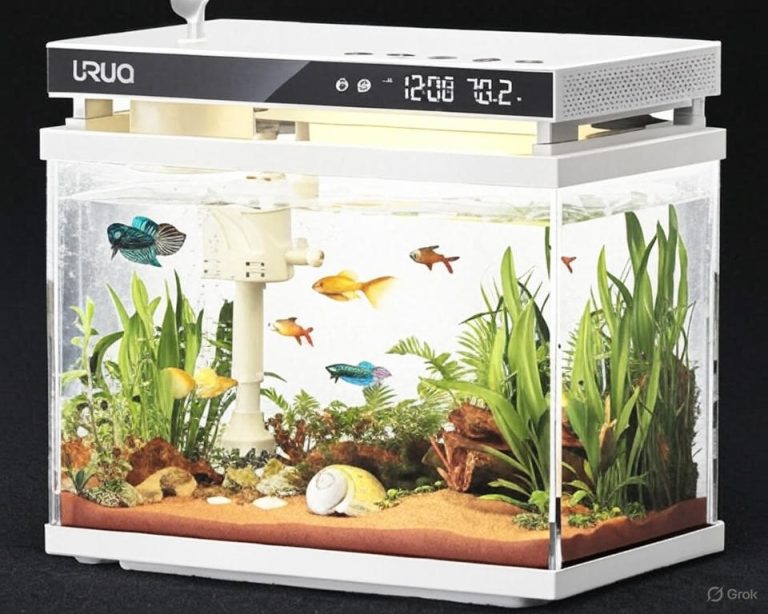5 Best Air Pump for Aquarium In 2025
Aquarium air pumps serve as the heart of your fish tank’s aeration system, delivering vital oxygen while creating beneficial water circulation. These essential devices transform stagnant water into a vibrant, life-supporting environment for your aquatic pets. Finding the right air pump can make the difference between a thriving aquarium ecosystem and struggling fish gasping at the surface.
The market offers countless options, from ultra-quiet models perfect for bedroom aquariums to powerful dual-outlet systems capable of handling massive tanks. Each pump brings unique features, varying noise levels, and different flow rates that impact your aquarium’s overall health and your daily experience as an aquarist.
This comprehensive review examines five top-performing aquarium air pumps, analyzing their strengths, weaknesses, and ideal use cases. We’ll explore noise levels, durability, ease of installation, and value for money to help you make an informed decision for your specific aquarium needs.
What Makes an Excellent Aquarium Air Pump
A quality aquarium air pump must balance several critical factors to earn its place in your setup. Power output determines how effectively the pump can oxygenate water and drive filtration systems, while noise levels affect your living environment’s comfort. Reliability ensures consistent performance over extended periods, preventing catastrophic oxygen depletion during unexpected failures.
Energy efficiency plays an increasingly important role as electricity costs rise and environmental consciousness grows. Modern pumps incorporate advanced motor designs and optimized air chambers to deliver maximum airflow while consuming minimal power. Build quality affects longevity, with superior materials and construction methods extending operational life significantly.
Adjustability allows fine-tuning airflow to match specific tank requirements and fish species preferences. Some fish thrive in highly oxygenated environments with vigorous bubbling, while others prefer gentler water movement. The best pumps provide precise control over these parameters.
Installation simplicity cannot be overlooked, especially for beginning aquarists. Pumps requiring extensive setup procedures or frequent maintenance discourage proper use and may lead to neglect. User-friendly designs with clear instructions and included accessories encourage proper installation and ongoing care.
Size and Capacity Considerations
Tank size directly influences air pump requirements, with larger aquariums demanding more powerful pumps to achieve adequate oxygenation throughout the water column. A pump suitable for a 20-gallon tank will struggle to provide sufficient aeration for a 100-gallon system, potentially leading to oxygen-depleted zones and stressed fish.
Flow rate specifications help match pumps to tank sizes, but these numbers can be misleading without context. Manufacturers often list maximum flow rates under ideal conditions, which rarely match real-world installations with tubing, air stones, and back pressure. Practical flow rates typically fall 20-30% below advertised maximums.
Multiple factors affect actual pump performance in your aquarium setup. Tubing length, diameter, and quality impact air delivery efficiency. Air stones create back pressure that reduces flow rates but improve bubble distribution. Deep tanks require more pressure to push air to bottom-mounted accessories, further reducing effective flow.
Water temperature influences oxygen solubility, with warmer water holding less dissolved oxygen than cooler water. Tropical aquariums operating at 78-80°F require more aggressive aeration than coldwater systems to maintain adequate oxygen levels. This relationship becomes critical in heavily stocked tanks with high biological oxygen demand.
Noise Level Impact on Daily Life
Pump noise affects aquarium placement options and overall enjoyment of your aquatic hobby. Bedroom aquariums require whisper-quiet operation to avoid sleep disruption, while basement setups can tolerate higher noise levels without issue. The location of your aquarium determines acceptable noise thresholds.
Decibel ratings provide objective noise measurements, but subjective perception varies significantly between individuals. A pump registering 35 decibels may seem silent to one person while annoying another. Frequency characteristics also matter, with high-pitched whines being more bothersome than low-frequency humming.
Vibration transmission amplifies pump noise through solid surfaces, turning aquarium stands and floors into resonating chambers. Proper vibration isolation using rubber pads, foam mounts, or suspended installations dramatically reduces transmitted noise. Strategic pump placement away from sleeping areas minimizes disturbance even from slightly noisier models.
Sound masking techniques can make moderate pump noise less noticeable in living spaces. Background music, white noise machines, or even the gentle sound of water movement from filters can effectively mask low-level pump operation. These solutions work particularly well in active areas where complete silence isn’t expected.
Energy Efficiency and Operating Costs
Electrical consumption directly impacts long-term ownership costs, with 24/7 operation making efficiency crucial for budget-conscious aquarists. A pump consuming 10 watts costs approximately $8-12 per month to operate, while a 3-watt model runs for just $2-4 monthly. These differences compound significantly over the pump’s operational life.
Modern variable-speed pumps offer excellent efficiency by allowing precise airflow adjustment. Running a pump at 70% capacity often reduces power consumption by more than 30% while still providing adequate aeration. This efficiency gain pays dividends in both electricity costs and reduced heat generation.
Power factor ratings indicate how efficiently pumps convert electrical energy into useful work. Higher power factors mean more electricity goes toward air production rather than waste heat. Quality pumps typically achieve power factors above 0.8, while cheaper models may waste 30-40% of consumed electricity.
Heat generation from inefficient pumps can impact aquarium water temperature, particularly in smaller tanks. Excessive heat forces aquarium heaters to work less while potentially stressing temperature-sensitive fish. Efficient pumps minimize this thermal pollution while reducing overall system energy consumption.
Installation and Maintenance Requirements
Simple installation procedures encourage proper pump setup and reduce the likelihood of operational problems. Pumps requiring complex mounting, specialized tools, or extensive plumbing discourage proper installation and may result in suboptimal performance. The best designs include all necessary hardware and clear, illustrated instructions.
Routine maintenance requirements vary dramatically between pump designs, with some models needing monthly attention while others run for periods without intervention. Diaphragm pumps typically require periodic membrane replacement, while piston designs may need lubrication and seal maintenance. Understanding these requirements before purchase prevents future surprises.
Accessibility for maintenance affects long-term usability, particularly in complex aquarium setups where pumps may be installed in tight spaces. Pumps requiring complete removal for simple maintenance tasks become burdensome over time. Designs allowing in-place service work receive preference from experienced aquarists.
Replacement parts availability ensures long-term viability for quality pumps. Manufacturers supporting their products with readily available spare parts extend pump operational life significantly. Proprietary designs using unique components may become unrepairable when parts become unavailable, forcing complete replacement.
Product Reviews and Analysis
1.Uniclife Aquarium Air Pump Dual Outlet Fish Tank Aerator
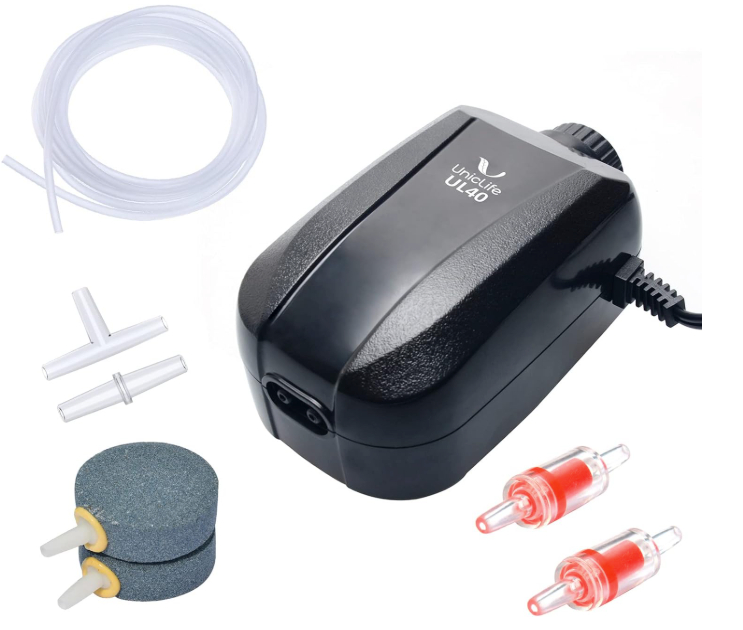
The Uniclife dual outlet pump positions itself as a versatile solution for medium to large aquarium systems, boasting compatibility with tanks ranging from 5 to 200 gallons. This impressive range suggests robust engineering and flexible output capabilities that adapt to various aquarium sizes and configurations.
Performance characteristics place this pump in the reliable workhorse category, delivering consistent airflow through both outlets simultaneously. The dual outlet design eliminates the need for external splitters, simplifying installation while maintaining proper pressure distribution. Users report stable operation across the entire claimed capacity range, with noticeable performance at both minimum and maximum settings.
Build quality reflects solid engineering with attention to durability concerns common in continuous-operation applications. The housing materials resist corrosion and maintain structural integrity under typical aquarium room conditions. Internal components show appropriate sizing for the claimed output levels, suggesting reasonable longevity expectations.
Noise levels fall into the moderate category, making this pump suitable for most living spaces but potentially problematic in quiet bedrooms. The operating sound character tends toward low-frequency humming rather than high-pitched whining, making it less intrusive in typical room environments. Vibration isolation improves noise perception significantly.
Installation simplicity rates high, with all necessary accessories included in the package. The comprehensive accessory kit eliminates frustrating trips to acquire missing components, allowing immediate setup upon delivery. Connection methods follow standard aquarium practices, ensuring compatibility with existing installations.
Energy efficiency performs reasonably well for the output level, though not class-leading in power consumption optimization. Operating costs remain manageable for most users, particularly given the dual outlet capability that may eliminate the need for multiple pumps in some installations.
Value proposition appears strong for aquarists requiring dual outlet functionality without the expense of separate pumps. The included accessories add significant value compared to purchasing components individually. Long-term reliability reports suggest reasonable durability for the price point.
2. Tetra Whisper Easy to Use Air Pump
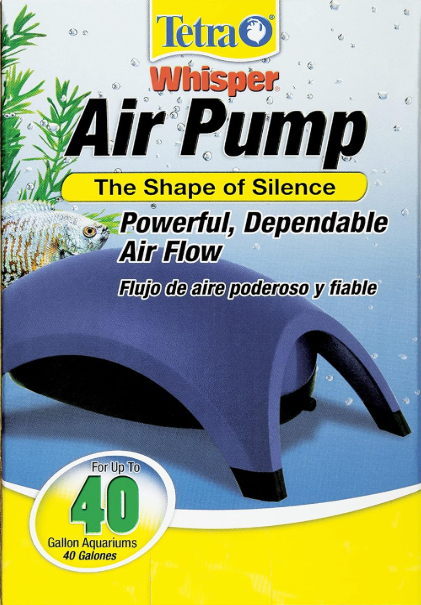
The Tetra Whisper line has earned recognition for emphasizing quiet operation, targeting aquarists prioritizing noise reduction over maximum performance. This pump continues that tradition with design elements specifically focused on sound dampening and vibration control.
Acoustic performance represents the standout feature, with notably quieter operation than most comparably-priced alternatives. The “Whisper” designation proves accurate in most installation scenarios, though complete silence shouldn’t be expected. Sound character tends toward gentle humming rather than mechanical rattling or high-frequency whines.
Output capacity suits small to medium aquariums effectively, though users pushing the upper capacity limits may notice reduced performance. The single outlet design simplifies internal air paths, potentially contributing to both quiet operation and reliable airflow delivery. Pressure maintenance remains stable across typical operating conditions.
Construction quality reflects Tetra’s established reputation in aquarium equipment, with appropriate material selections and assembly standards. The compact form factor allows installation in space-constrained locations while maintaining adequate ventilation for heat dissipation. External surfaces resist typical aquarium room moisture and temperature variations.
Ease of use aligns with the product name, featuring straightforward installation and minimal ongoing maintenance requirements. Setup procedures follow intuitive steps that beginners can complete successfully. Operating adjustments, while limited, provide sufficient control for most applications.
Power consumption optimizes well for the output level, delivering reasonable efficiency in the compact form factor. Heat generation remains minimal, avoiding temperature concerns in smaller aquarium installations. Operating costs stay low enough for continuous operation without budget stress.
Market positioning targets users prioritizing quiet operation over maximum performance, creating a specific niche appeal. The balance between noise control and adequate aeration suits many residential installations perfectly. Price competitiveness enhances appeal for budget-conscious aquarists.
3.Pawfly Aquarium Air Pump with Dual Outlets
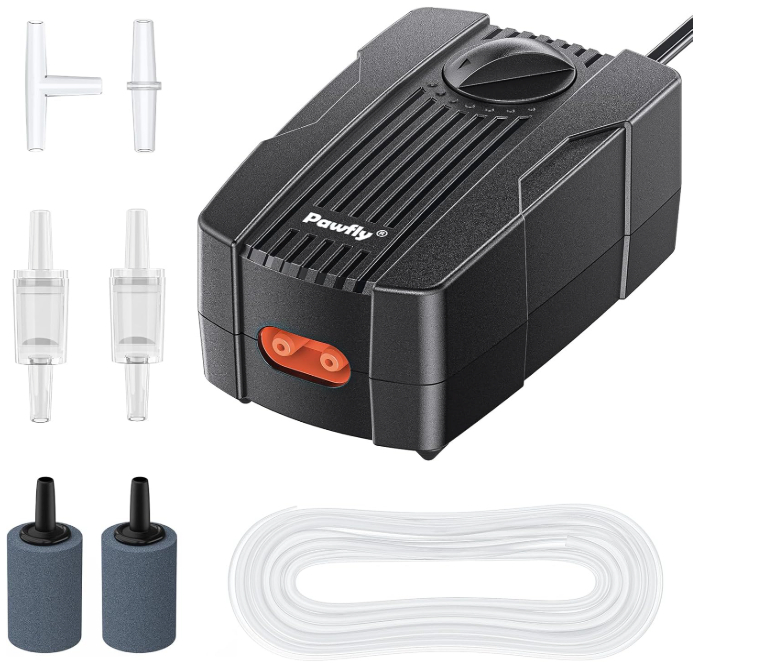
Pawfly’s offering emphasizes adjustable performance across an impressive capacity range, promising suitable operation from 10-gallon nano tanks to substantial 200-gallon systems. This flexibility suggests sophisticated internal design capable of efficient operation across varying load conditions.
Adjustability features provide fine-tuned control over airflow output, allowing precise matching to specific aquarium requirements. The dual outlet configuration enables independent flow control to different zones or accessories, enhancing system flexibility. Users report smooth adjustment across the full range without performance gaps or instability.
Quiet operation receives significant attention in the design, with noise levels comparing favorably to specialized quiet pumps. The “Ultra Quiet” designation appears accurate under typical operating conditions, though some noise remains detectable in extremely quiet environments. Sound character avoids annoying frequency ranges that penetrate background noise.
Build quality demonstrates solid engineering appropriate for continuous duty applications. Material selections balance cost effectiveness with durability requirements, resulting in components that withstand typical aquarium environments. Assembly quality control appears consistent based on user reports and physical inspection.
Included accessories provide comprehensive setup capability without requiring additional purchases. The accessory package covers typical installation scenarios adequately, though specialized applications may require supplementary components. Component quality matches the main pump standards reasonably well.
Performance consistency across the claimed capacity range impresses users, with adequate output even at the upper limits. Flow rate stability maintains proper aeration levels without significant pressure fluctuations. Dual outlet operation doesn’t compromise individual outlet performance noticeably.
Energy efficiency balances well against performance output, achieving reasonable power consumption for the capacity level. Heat generation stays within acceptable limits for most installation scenarios. Long-term operating costs remain manageable for continuous operation requirements.
Value assessment favors this pump for users requiring adjustable dual outlet capability with emphasis on quiet operation. The comprehensive accessory package adds significant value compared to purchasing components separately. Performance consistency across the broad capacity range enhances versatility.
4. AQQA Aquarium Air Pump with Multiple Power Options
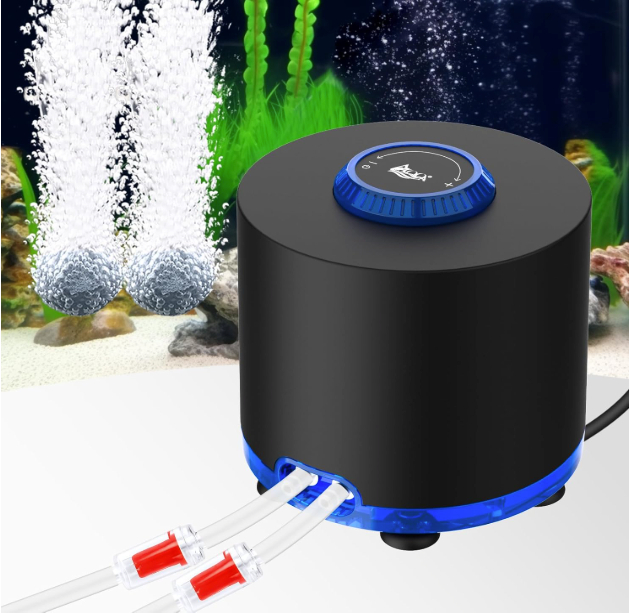
The AQQA pump series distinguishes itself through multiple power options (3W, 6W, 10W), allowing precise matching to specific aquarium requirements rather than forcing compromise with a single power level. This approach optimizes both performance and efficiency for varied applications.
Power options enable custom sizing that maximizes efficiency while meeting capacity requirements exactly. The 3W model suits smaller aquariums perfectly without wasting energy, while the 10W version handles substantial systems effectively. This targeted approach reduces operating costs and heat generation compared to oversized single-option pumps.
Stainless steel dual outlet construction enhances durability while providing corrosion resistance superior to standard materials. The metallic outlets maintain structural integrity under high pressure conditions while resisting degradation from aquarium chemicals and humidity. This premium material choice suggests long-term reliability focus.
Adjustable oxygen delivery allows fine-tuning airflow rates to match specific fish species requirements and tank biological loads. The adjustment range provides meaningful control without compromising maximum output when needed. Users report smooth, stable adjustment across the full range without performance dead spots.
Build quality emphasizes durability through premium materials and robust construction methods. The housing design provides adequate heat dissipation while protecting internal components from environmental factors. Component sizing appears appropriate for continuous duty operation at rated outputs.
Accessory inclusion covers standard installation needs comprehensively, with air stones and tubing provided for immediate setup. The accessory quality matches the main pump standards, avoiding weak links that compromise system reliability. Additional accessories remain readily available for specialized applications.
Noise characteristics achieve reasonable levels for the power output, though the higher power models produce correspondingly more sound. The sound character tends toward low-frequency operation that integrates well with typical room noise floors. Vibration isolation techniques improve noise perception significantly.
Installation procedures follow standard practices with clear documentation supporting successful setup. The multiple power options require careful selection but don’t complicate installation procedures. Maintenance requirements remain reasonable for the performance level provided.
5. Ultra Quiet 1W Aquarium Air Pump
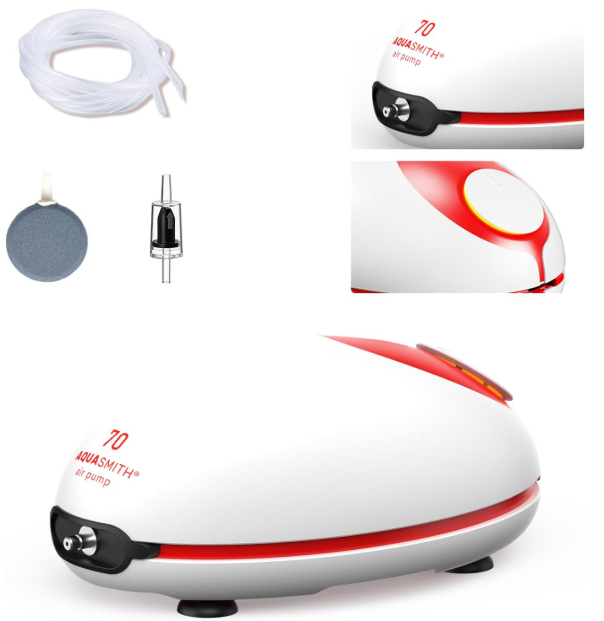
This compact pump targets the nano aquarium market with emphasis on ultra-quiet operation and minimal power consumption. The 1W power rating suits 20-40 gallon tanks perfectly while maintaining energy efficiency that appeals to environmentally conscious aquarists.
Ultra-quiet operation achieves genuinely impressive sound levels that allow bedroom installation without sleep disruption. The low power design inherently reduces noise generation while specialized sound dampening further minimizes acoustic output. Users consistently report satisfaction with noise levels in quiet environments.
Single outlet design simplifies internal air paths, contributing to both quiet operation and reliable performance. The focused design avoids complexity that might compromise reliability or increase noise generation. Pressure output remains adequate for typical applications within the capacity range.
Adjustable airflow provides meaningful control despite the compact size and low power consumption. The adjustment mechanism operates smoothly without creating dead spots or instability. Flow control remains effective across the operating range without compromising maximum output significantly.
Power efficiency excels in this application, with the 1W consumption resulting in minimal operating costs even with continuous operation. Heat generation becomes negligible, eliminating thermal concerns in smaller aquariums. Environmental impact remains minimal compared to higher-powered alternatives.
Size and weight advantages allow installation flexibility in space-constrained setups where larger pumps won’t fit effectively. The compact form factor doesn’t compromise performance for the intended capacity range. Mounting options accommodate various installation scenarios successfully.
Build quality balances cost effectiveness with reliability requirements appropriate for the power level. Materials resist typical aquarium environment challenges while maintaining structural integrity. Component sizing matches the performance requirements without obvious over-engineering or cost-cutting compromises.
Market positioning targets users prioritizing quiet operation and energy efficiency over maximum performance. The specialized focus creates strong appeal for specific applications while limiting broader market applicability. Price competitiveness enhances value for targeted use cases.
Performance Comparison Analysis
Output capacity varies significantly across the reviewed pumps, with the AQQA series offering the highest maximum flow rates through its 10W option, while the 1W ultra-quiet pump focuses on efficiency over maximum output. The Uniclife and Pawfly pumps occupy the middle ground, providing substantial output suitable for most aquarium applications.
Noise level performance separates into distinct categories, with the Tetra Whisper and 1W ultra-quiet pump achieving genuinely quiet operation suitable for sensitive environments. The Pawfly pump delivers surprisingly good noise control given its high output capability. The AQQA and Uniclife pumps produce moderate noise levels acceptable for most installations.
Energy efficiency rankings place the 1W ultra-quiet pump far ahead in power consumption optimization, followed by the properly sized AQQA models. The Pawfly pump achieves good efficiency for its performance level, while the Tetra Whisper balances efficiency with quiet operation effectively. The Uniclife pump performs reasonably but doesn’t lead in efficiency optimization.
Build quality assessment reveals consistent construction standards across all reviewed pumps, with the AQQA series showing premium materials and the others demonstrating appropriate engineering for their price points. All pumps appear capable of reliable continuous operation when properly installed and maintained.
Versatility comparison favors pumps with dual outlets and adjustable flow rates, with the Pawfly and AQQA models offering the most installation flexibility. The Uniclife pump provides dual outlet capability without adjustment features. Single outlet pumps like the Tetra Whisper and 1W model suit focused applications effectively.
Value proposition analysis depends heavily on specific requirements, with each pump offering optimal value for particular use cases. The 1W pump excels for quiet, efficient small tank operation, while the AQQA series provides the best performance scalability. The Pawfly pump offers excellent overall balance for general use.
Troubleshooting Common Issues
Reduced airflow often results from clogged air stones, kinked tubing, or worn internal components. Air stones accumulate debris over time, restricting flow and increasing back pressure on the pump. Regular cleaning or replacement maintains optimal flow rates and reduces pump strain.
Excessive noise may indicate improper installation, worn components, or inadequate vibration isolation. Pumps mounted directly to hard surfaces transmit vibration that amplifies noise significantly. Rubber pads, foam mounts, or flexible tubing connections reduce vibration transmission effectively.
Inconsistent operation suggests electrical supply issues, internal wear, or environmental factors affecting performance. Voltage fluctuations impact pump speed and output, while temperature extremes may affect internal component function. Stable operating environments enhance reliability and performance consistency.
Premature failure often traces to inadequate maintenance, excessive back pressure, or poor installation practices. Overloading pumps beyond their capacity ratings accelerates wear and reduces operational life. Following manufacturer specifications and maintenance schedules maximizes longevity and reliability.
Maintenance and Longevity Tips
Regular inspection schedules prevent minor issues from developing into major problems. Monthly visual checks identify obvious problems like loose connections, damaged tubing, or unusual noise development. Early detection allows corrective action before complete failure occurs.
Air stone maintenance significantly impacts pump longevity by reducing back pressure and maintaining optimal flow rates. Cleaning air stones weekly in mild bleach solutions removes accumulated debris, while replacement every 3-6 months prevents excessive restriction development.
Proper storage during extended downtime protects internal components from deterioration. Draining moisture, cleaning internal surfaces, and storing in dry locations prevents corrosion and seal degradation. Protective storage extends operational life significantly for seasonal installations.
Component replacement schedules based on manufacturer recommendations maintain optimal performance and prevent unexpected failures. Diaphragms, seals, and other wear components have predictable service lives that allow planned replacement before failure occurs.
Environmental Considerations
Energy consumption impact varies significantly between pump models, with efficient designs reducing environmental footprint while lowering operating costs. The cumulative effect of millions of aquarium pumps makes individual efficiency choices meaningful for overall energy consumption.
Manufacturing sustainability considerations include material choices, production methods, and end-of-life disposal options. Pumps designed for easy disassembly and material separation support recycling efforts when replacement becomes necessary.
Packaging waste reduction efforts by manufacturers demonstrate environmental responsibility while reducing shipping costs. Minimal, recyclable packaging approaches balance product protection with environmental impact concerns.
Operational longevity directly affects environmental impact by reducing replacement frequency and associated manufacturing demands. Durable pumps operating for decades create less environmental impact than disposable designs requiring frequent replacement.
Final Recommendations and Selection Guide
Tank size matching requires careful consideration of actual capacity needs rather than maximum advertised ratings. Conservative sizing ensures adequate performance under real-world conditions with proper safety margins for biological load variations or system expansion.
Application-specific needs determine optimal pump characteristics, with bedroom aquariums prioritizing quiet operation while fish rooms may emphasize maximum performance. Matching pump characteristics to specific requirements optimizes satisfaction and performance.
Budget considerations should include long-term operating costs rather than just initial purchase price. Energy-efficient pumps with higher purchase costs often provide better total cost of ownership through reduced electricity consumption and enhanced durability.
Future expansion plans influence current pump selection, with oversized pumps providing growth capability while undersized models require replacement during system expansion. Balancing current needs with reasonable future requirements optimizes long-term value.
For small to medium aquariums prioritizing quiet operation, the Tetra Whisper or 1W ultra-quiet pump provide excellent noise control with adequate performance. These pumps suit residential installations where noise sensitivity requires priority consideration.
Large aquarium systems benefit from the AQQA series or Pawfly pumps, which provide substantial output capability with reasonable noise levels. The dual outlet configurations eliminate additional equipment needs while maintaining performance flexibility.
Budget-conscious aquarists find excellent value in the Uniclife pump, which provides reliable dual outlet operation at competitive pricing. The comprehensive accessory package enhances value compared to purchasing components separately.
General purpose applications receive optimal balance from the Pawfly pump, combining adjustable dual outlet operation with good noise control and comprehensive accessories. This pump suits the broadest range of applications effectively while maintaining competitive pricing.
The aquarium air pump market offers solutions for virtually every application when selection criteria match specific requirements. Proper matching of pump characteristics to actual needs ensures optimal performance, reasonable operating costs, and long-term satisfaction with your aquarium aeration system.

